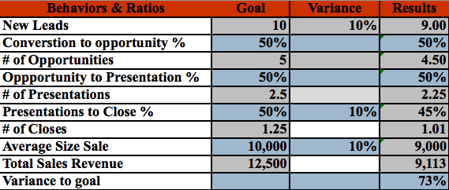In this article, we offer solutions for your CRM system and provide 5 concrete steps in helping your salespeople improve their numbers and ratios so that a sales manager can more accurately identify choke points in the sales process.

My wife Linda and I were recently in Columbia, Maryland visiting family. While having a mid-afternoon lunch at Clyde’s, I happened to see a “LifeLock” commercial on the bar TV. All I caught was the following caption:
“Why Monitor If You're Not Going to Fix It”?
Forbes contribution editor, Will Burns, writes about the absurdity the Lifelock ads point out. He even does us the favor of including the Dentist, Robbery and Pest Control ads in his article.
Many companies, probably including yours, have monitored pipeline opportunities. The idea is to have information about the opportunities being created by the sales team. Companies want to know:
- What stage in the sales process is the opportunity
- What the next steps are to move the opportunity through the pipeline
- The likelihood of winning the business based on a probability % either calculated or assumed based on the sales stages
- The future sales revenue of all the opportunities in the pipeline.
There are normally at least three problems with the use of CRMs and pipeline management:
- Validity - The true accuracy (validity) of the predictive nature of the CRM is dependent upon making sure that a milestone centric sales process has been mapped and made to be part of the CRM being used.
- Credibility – Even if you have the right sales process mapped and documented, there is still the element of GIGO – Garbage In, Garbage Out. If your sales team is entering opportunities into the pipeline to keep management off of their back and assuming that the opportunities have met the criteria for each step in the sales process, then you still have a predictive problem with your pipeline.
- Lack of helpful business intelligence – It’s one thing to enter data and get raw numbers from what has happened and what we think will happen. It’s another thing to build your CRM so that you have reporting that tells you how sales people are performing against the sales success formula developed for each individual. Without comparative data, then a company or manager is monitoring activity without identifying, if in fact, there are any problems.
What a company should be looking for, so that it’s in a position to ‘fix it’, are critical numbers and ratios so that a sales manager can clearly and more accurately identify choke points in the sales process for each individual. Additionally, the data can and should, tell the manager and the organization if training and coaching is required, or if the current training and coaching is having the intended impact: Improving the effectiveness and results of the sales team.
Let’s assume the following sales effort and effectiveness performance model:

- The sales person that is failing to hit sales targets is supposed to:
- Create 10 new leads a month
- Convert 50% of those into opportunities
- Convert 50% of those into presentations
- And get 50% of those presentations to turn into sold business
- Additionally the average size sales is supposed to be $10,000.00
- Lets assume the following actual sales effort and effectiveness:
- 9 new leads are being created but we don’t know why 9 instead of 10?
- 50% of leads are being converted to opportunities
- 50% of those opportunities are leading to presentations (but keep in mind over time there will only be 90% of the planned for opportunities because of failure to hit the lead goal)
- 45% of the presentations turn into sold business instead of 50%
- And, the average size sale is $9,000.00 instead of $10,000.00
If this is monitored and not addressed/fixed, then this sales person will be short of their goal in access of 25%. This will be a gradual event because, unless the CRM is built to provide this information, no one will notice. No one will notice because the numbers are either: not being monitored or not being addressed because they are ‘close enough’ (9 instead of 10. Management sees this as being 1 off of target rather than 10% off target). Or, coaching to fix the problem falls into the category of ‘do more’ instead of "let’s coach you on how to do better."
Does any of this look or sound familiar? It may not, especially if you have enough of the right people (about 33% of your sales group) doing enough of the right things. With 33% of the team carrying the load, you will still end up with about 90% of your goal. Then, all you will need is a few of the remaining 67% of the team to contribute something to the production number. You will be close enough.
“Fixing” it has to be part of the investment when investing in sales enablement tools, systems and technology. Fixing the problem requires the following 5 steps:
- Building a milestone centric sales process that is part of the CRM
- Creating sales success formulas for each sales person based on their historical actual performance and agreed to sales goals
- Timely monitoring and updating of sales effort and sales execution data so that you can ‘catch them early’ in real-time when their performance is a negative variance from the plan
- Using the data to develop intentional coaching strategies to help your salespeople deal with the specific challenges they are having in either effort or execution. No more ‘run faster’ coaching
- Use metrics to determine your success:
- % of sales people hitting effort target increases to 100%
- % of people hitting conversion ratios improves
- Production from each of the sales team segments (1/5s) improves year over year
- The 80/20 rule starts to shift to a 70/30 > 60/40 rule
- Validity and credibility in your pipeline prediction improves
- Adaption of your CRM is at 100%
Call To Action:
Request a 30-minute live Emergency Pipeline Analysis Session to evaluate current opportunities in your pipeline. What you will get/learn.
- Complete instruction on how to more effectively evaluate the validity and credibility of your pipeline opportunities
- How to more effectively identify choke points in the sales process
- A method of intentional coaching to improve the probability of closing current opportunities.
Email: tony@anthonycoletraining.com if interested. Thank you for your time!
Like what you read? Click the link below to subscribe to The Sales Management Expert blog here:






